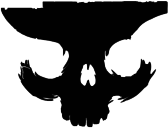Hobbying Failed Prints!
By Guest Blogger Jordan Cuffie of Skull Forge Studios
That's no failed print... That's... Battle Damage!
For many 3D printing enthusiasts failed prints are more common than successful prints, whether something knocked the printer half way through a print, or your settings were off for that new PLA. That doesn't mean you have to toss a half printed piece into the garbage however!
Tools Required
- A failed print
- Pliers
- Bonder Auto filler
- Sandpaper (low medium and high grit)
- Hamster bedding (the shredded cardboard variety)
- Plywood
- Basing material (grout, sand, in this case BBQ ash!)
- Isopropyl alcohol in a misting bottle
- ⅓ PVA glue ⅔ water in a squirt bottle
As long as your print stuck to the bed, you've got something salvageable, but if all you've got is a spiders mess of PLA you're better off tossing that out. Hopefully, you've got enough of a print to only require light modification, but if your print is only a few millimeters high you should break up the piece and use it for rubble (stay tuned for a future article on FDM scrap rubble!)
Here we have some failed prints from the Landing Bay set in this print you can see halfway through, the piece shifted, resulting in an offset. It's noticeable enough that I decided the wall would need some proper battle damage, so I took a pair of pliers and started opening up the print around the offset. The lattice pattern of the infill looks great as torn scrap metal. I also added some bits from the Hans speeder model kit and some electrical tubing.
After I was happy with the battle damage effect I added some small rock debris, sand, and hamster bedding. You'd be surprised how good the bedding looks as scrap debris when painted up, and it's very easy to apply, just push the bedding in a nook or cranny, spray some isopropyl alcohol to hold the particles and squirt a mixture of ⅓ water ⅔ PVA glue, till the bedding is soaked.
With the Desert Tower, I decided that I wanted to use a top piece for a different structure and picked up a metal ventilation cover from my local hardware store and thankfully it was a perfect fit! I applied some hot glue to secure the new roof.
I cleaned up the prints with the process of filling the heavily layered areas with bondo auto filler, sanding the bondo, then applying more bondo (and of course more sanding again)
There are many ways to add texture to your 3D prints, and I've found my method works great for making your piece look more like smoothed concrete or metal.
I like to use thin plywood as a base for all my terrain, cut roughly to fit the terrain, and sanded down for handling. The plywood is more sturdy than cardboard or mdf, and though you have to work a little harder to properly sand down the edges, the sawdust is a lot less harmful than the particulants created from sanding down mdf. The plywood can be found at most craft stores, I source mind from Joanns.
I use hot glue to attach the prints to plywood and applied a little extra around the edges of the print to ensure full adhesion. After the terrain is attached you can either move onto painting and base afterwards or base your terrain if you want your basing to receive the same base coat as your terrain, for these pieces I chose to paint my terrain before I moved onto basing. I liked the color profile of the republic cruiser from The Phantom Menace, so I used that color scheme for the buildings.
After the terrain was painted I covered the plywood with BBQ ash from my weber grill, not only is your terrain going to look great, it's also going to smell wonderful too. The ash is applied haphazardly, you can pour it on with a spoon, or use a large paint brush as a shovel. Lightly tap the sides of your base to ensure the ash settles a bit, then mist on some isopropyl alcohol until the ash is moist, and drip on a heavy amount of the water and PVA mix, the moistness of the ash will pull in the adhesive like pouring water onto wet sand. I use a squirt bottle to apply the glue, these can be found at various retail outlets like Target, Joanns, Sur-La-Table. After the ash dries I like to drip on some extra glue as a sanity check then spray the whole piece with some Tamiya lacquer.
There you have it, only a few small adjustments can elevate a seemingly failed print to a great set piece for your table.
Looking for some ready to print table scatter? Check out our scatter terrain.

